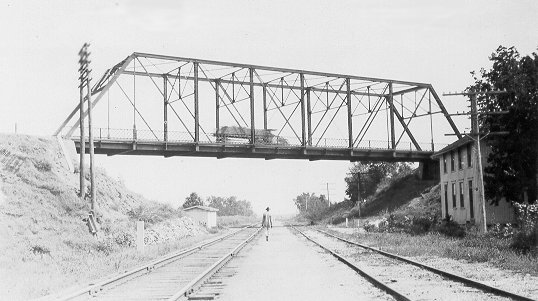|
WARREN WITH VERTICALS PONY TRUSS
1905 Garvin 25D3120E1700009
1906 Garfield 24N2890E0510003 Jno. Gilligan Const.
1907 Lincoln 41E0760N3420003 Missouri Valley Br.
1910 Jackson 33E1670N2010001 Austin Bros.
1910 Muskogee 51E0990N4260006 Vincennes Br.
1910 Payne 60N3340E0530006
1911 Alfalfa 02E0210N2740005 Kansas City Br.
1911 McIntosh 46E1010N4170003 Massillon Br.
1911 Muskogee 51N4110E0840009 Vincennes Br.
1912 Jefferson 34E1975N2790006 Midland Br.
1914 Tulsa 72E0410N3940008 R.K. Hughes
1914 Woodward 77N3400E0570005 Boardman Co.
1917 Payne 60N3400E0660007 Canton Br.
1917 Washington 74N4010E0020005 Rochester Br.
1919 Pawnee 59N3470E0520004 Pioneer Const.
1921 Hughes 32E1200N3930000 Vincennes Br.
1926 Payne 60E0600N3190002 Boardman Co.
1928 Grady 26E1160N2840009 J.B. Klein
1928 Okmulgee 56E1030N3940001 J.B. Klein
1928 Woodward 77N1990E0390008 American Br.
c1930 Cleveland 14N3160E1170001
First place among Oklahoma's steel trusses in tems of numbers and distribution around the state belongs to the Warren pony, particularly as a consequence of the highway department making it a standard structural type as of the 1920s (Figure 55). Today approximately 560 of these structures remain from before 1955, comprising more than one-third of the full inventory of historical bridges. They were made along standard lines, with vertical members inserted to reduce the length of unsupported chord between diagonals and riveted at panel points. Their lengths generally varied between 40 and 80 feet, though some were built in longer spans, and proved ideally suited for service on secondary routes and other moderately traveled roads in Oklahoma. The principal bridge building companies in the state could supply this type, and, judging from documented structures in existance, the leading firms included the Vincennes Bridge Company, Midland Bridge and Iron, Rochester Bridge Company, Kansas City Bridge Company, and Oklahoma City's J. B. Klein Iron and Foundry. Notable for its association with a local engineer, a 58-foot Warren standing over a creek near Skiatook has a nameplate identifying the builder as R. K. Hughes of Tulsa. Hughes worked as a county engineer and on occasion as an agent for bridge companies.
The story of one standard type Warren truss can reveal the way Oklahoma aquired some of its bridges in the 1920s, a period of expansion. Payne County, with its growing Oklahoma Agricultral and Mechanical College (Oklahoma State University) located in the county seat of Stillwater, needed better bridges on rural roads. Based on plans (which still exist), the county commissioners received bids and awarded a contract to the Boardman Company in Oklahoma City for a 52-foot Warren pony with verticals. Boardman apparently purchased steel from the Illinois Steel Bridge Company, fabricated the span, and employed a local man to erect the structure across Stillwater Creek in 1926. Small and utilitarian, it made use of angles riveted together by stay plates for verticals, diagonals, and bottom chord, a typical plan for the day (Figure 54).
Although invented in England during the 1840s, the Warren truss did not reach full potential until much later. With its distinctive triangular design between the chords, giving the appearance of elongated "W's" in the web, it performed best when made of steel, not the iron structural materal available at the time of its invention. Steel permitted stronger, more resilient diagonals which in the Warren were alternately subjected to tension and compression by the weight of passing loads. Likewise, pinned versions of this truss experienced greater wear at mid-span, a cause for concern among engineers. That problem, however, could be avoided with rivets. Thus, another technical advancement, the portable riveting machine that could be taken into field, contributed to the wider acceptance of the Warren. The intermediate verticals also added strength. The many Warrens remaining in Oklahoma attest to these technological changes related to bridge building.
While pin-connected Warren trusses are generally considered unusual, their historical value is increased by good documentation. This is true in the case of a fine structure, 15 feet wide and 32 feet long, built in 1906 by the John Gilligan Construction Company. The Gilligan company from Nebraska was awarded contracts only by Garfield County, the county buying this span for a creek south of Enid.

Figure 54. A major local fabricator of truss spans, Oklahoma City's Boardman Company erected Bridge 60E0600N3190002 near Stillwater in the 1920s. It typifies the small Warren or triangular ponies extensively used on Oklahoma roads between c1910 and c1930.

Figure 55. Measured drawing of a 47-foot Warren pony truss illustrates a standard design adopted throughout the state. By inserting vertical members engineers added strength to the floor system.
|



